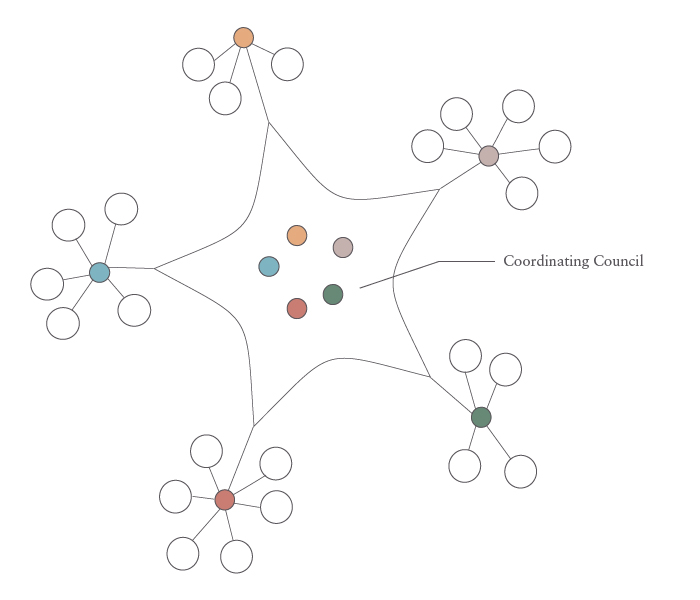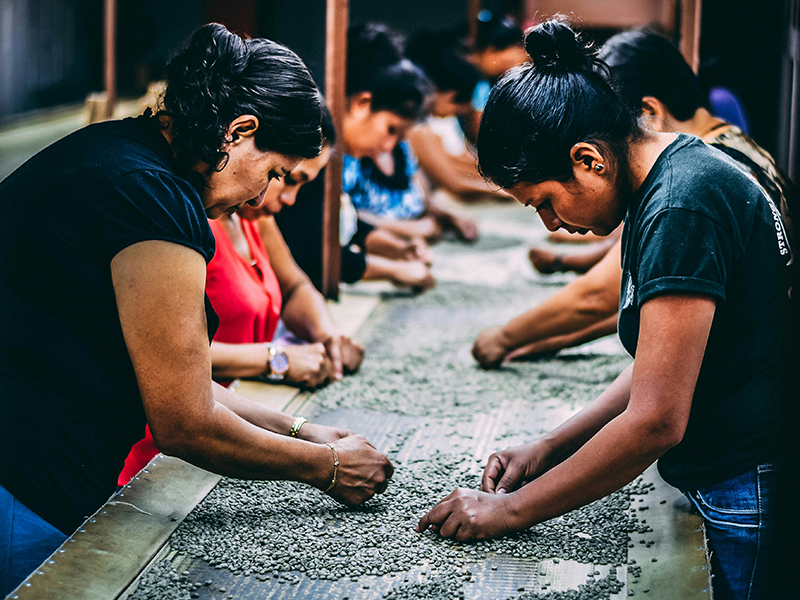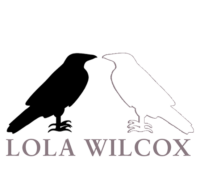
What kind of leader am I? Do I naturally want to lead people in a vertical chain of hierarchy? Or do I prefer to work horizontally, sharing power across the group? Or if I don’t want to lead, what kind of follower am I? Do I want to be given my work to do and be paid to do it well or do I want to share ideas and work to accomplish things with my team?
There are two vital and natural leadership processes that we are familiar with, and operate within, often without recognizing it or being conscious of our role in either one. And there are abnormal applications of both processes that create confusion and fear. I am offering the idea in this article that we might consider a third, Mycelium Leadership, based on our new knowledge of how vast networks work.
Three Natural Leadership Processes
Hierarchy
One leadership process is Hierarchy, which is vertical, with power distributed from the top to the bottom layer. Leaders at each level may consult others, but evaluate, take risks, and decide alone. Hierarchy functions very well without an authoritarian leader at the top. It’s important to re-read that sentence: Hierarchy functions very well without an authoritarian leader at the top. Let’s not confuse Arrogant Despot with a leader at the top of a hierarchy who sends information and tasks down the chain, and needs and uses information coming back.
We culturally just witnessed an event celebrating hierarchy in the recent coronation of King Charles III and Queen Camilla in England. In a functional hierarchy, power is shared by rank – beneath the royalty an organization expands layer by layer, with the power literally flowing downhill to the least empowered members. Individuals are named and charted.
Outside of a large window in our house we feed the birds from banana racines. The biggest birds eat first, and then it moves on down to the smallest ones. The rank is determined by size. I first think: hierarchy at work. When the sharp-beaked woodpecker comes even the big birds move aside. Eventually I realize the big beaks open the bananas, as do the woodpeckers even more efficiently. Without the big birds the little ones can’t access the food.
Faire Chain of Love
Geoffrey Chaucer in the Canterbury Tales (in 1387) describes the Faire Chain of Love… hierarchy at its best. He states here, and the Tales illustrate, that it is love that flows down, and by love the First Mover binds all together, including the elemental earth.
The Firste Moevere of the cause above,
Whan he first made the faire cheyne of love,
Greet was th’effect, and heigh was his entente.
. . .
For with that faire cheyne of love he bond
The fyr, the eyr, the water, and the lond
In certeyn boundes, that they may nat flee.
(The Knight’s Tale, 2987–2993)
Chaucer describes the heart of Hierarchical Leadership as Love, cascading down the cheyne. More from Chaucer is available on my blog here.
Distributed
The second leadership process is Distributed or Horizontal Leadership. A vertical leader knows first and tells the rest. A horizontal leader holds the space of creativity, information, innovation and management as an incubator for all to learn from each other and create outcomes. After the initial formation of a group there might not be a formal leader.
Two examples:
Food Co-op
When organic food began to emerge in the USA, a group of young mothers formed a food cooperative to buy organic food in bulk. There were small committees for meats, cheese, grains, spices and teas, green vegetables. Each person ordered once a month. Each food specialty group ordered wholesale, and all orders were delivered to a home at first and eventually a church. Because everything came in bulk, we all met and divided our committee’s products for the rest of the group. Family bags and boxes lined a wall or table, and once you cut their 2 pounds of cheese, or bagged their broccoli, you walked it over and put it in the right box. We met once a quarter for a potluck to look at new products, discuss issues and ideas. We did this for over ten years. Some people came, went, new people came but the core and the process stayed the same. It ended naturally as children got older, people went to work full time, and organic grocery stores opened.
ACI
Distributed Leadership processes for Associated Consultants International (ACI), an organization I belonged to for decades are described in detail here.
Key Points of How ACI Distributed Leadership Worked:
- Lacking a hierarchy encouraged active membership, shared responsibility, and democratic principles.
- Standing and short-term committees managed all aspects of the organization.
- A Coordinating Council consisted of representatives from each of the standing committees (e.g., Programs, Peer Consultation and Peer Review).
- Representatives from the committees rotated to the Coordinating Council (CC) to provide synchronization, and make any decisions in clear alignment with the organization’s purpose and goals.
- Every two years the entire membership gathered for a “Whither ACI?” facilitated discussion.

Photo Credit: Soltan Tasi, Unsplash
Mycelium Leadership
A third option is Mycelium Leadership. Mycelium are fungal systems, out of sight in the ground, and interconnected with other living beings. Reading about them led me to think that what they are involves a different kind of leadership that we have thought about for a long time. Remote tribal people may be living examples of how we might have managed mycelium style leadership in the long-distant past.
Some quotes that served to generate my thinking:
Fungal systems are constituted by thread like mycelial networks below ground. With no predetermined body plan, they become maps of relationship wherever they grow. They branch and fork and fuse to constellate the connective network of other species and beings. —Myth & Mycelium, 2023 Earth Day Keynote for Saint John’s College, Sophie Strand
Despite lacking a nervous system, fungi seem to transmit information using electrical impulses across thread-like filaments called hyphae. The filaments form a thin web called a mycelium that links fungal colonies within the soil. These networks are remarkably similar to animal nervous systems. By measuring the frequency and intensity of the impulses, it may be possible to unpick and understand the languages used to communicate within and between organisms across the kingdoms of life.—Do mushrooms really use language to talk to each other? A fungi expert investigates, Katie Field, Professor in Plant-Soil Processes, University of Sheffield, April 2022.
Growing hyphae detect ridges on surfaces and respond to restrictions in their physical space. These are expressions of cellular consciousness. Fungal mycelia show decision-making and alter their developmental patterns in response to interactions with other organisms.—Hyphal and mycelial consciousness: the concept of the fungal mind,Fungal Biology, Nicholas P. Money, Volume 125, Issue 4, 2021.
We are at the beginning of rediscovering fungal mycelia as a being. We’ve already put our discoveries to use in a multitude of ways. Our partnership is just beginning.
When issues arise; decisions have to be made. How decisions are made gives us the leadership style.
Decision-Making Processes
Hierarchical:
The individual at the top of the hierarchy makes final decisions and holds all responsibility for them. Ideally, information flows up and down the chain. Subordinates make recommendations.
Distributed:
From ACI: There was never a voting process. If people reached concordance the change was accepted as a new norm or behavior. When strongly opposing values emerged around a decision:
- Individuals stated their values as clearly as possible, and reflective silence followed. The facilitator needed to be both skilled and able to wait while people considered their positions.
- If consensus could not be reached, strongly opposed members formed a short-term committee to work out a solution and present it to the full membership. If consensus on the issue could not be reached in the committee, individuals could participate in a preferred action but it was not a sponsored, organizational initiative.
Mycelium:
With the advent of Artificial Intelligence we will see competitive “Brains” from competitive companies out to “Win.” I believe AI basic design is closer to Mycelium intelligence. And I believe our human basic design may be less structural hierarchy along our spine, or hands joined in a circle dance, and more as a vast network of interconnected cellular beings—connected to every other living being on earth.
We may find there is no leader or method of decision making. There is a discovered request and an answer. It’s a true democracy, not a representative one. Each node is responsible to all the rest. A person gets a feeling and calls a friend they haven’t talked to for a long time; a suicide is turned into a renewed bond and help given. Walking along the path you see a person take a tumble; you ask if you can help, and help them get home safely. The whole Pay it Forward movement could be described s a Mycelium network.
I think organizations that create networks to be called on for aid to someone, somewhere in the world are another emerging example. A million people from all over the world become aware simultaneously of a desperate cause needing their help, and they respond with signatures and cash.
How do we explore being part of a mycelium network?
- Develop antennae to discover, explore, and understand the discoveries that will revolutionize our world, our way of thinking and our actions.
- Support the best of those discoveries.
- Tend our node in the network, and the nodes we are connected to, helping where we can.
- Trust that all the other nodes are also tending their immediate surroundings.
- Encourage “Leaders” to recognize the vast network where our entire world operates as a single living community.
- Help “Leaders” that emerge to organize a solution to a problem, and support them merging back when the project is over.
I believe we are realizing as a connected biome what way we need to journey, and that we will travel along that path together.
May it be so…
Comments:
The more I thought about mycelium leadership the more sure I became that it is worth exploring. Keep your attention alert to developments in this area, and let’s pass them along to each other. Send a comment about how this idea resonated (or not) with you.





